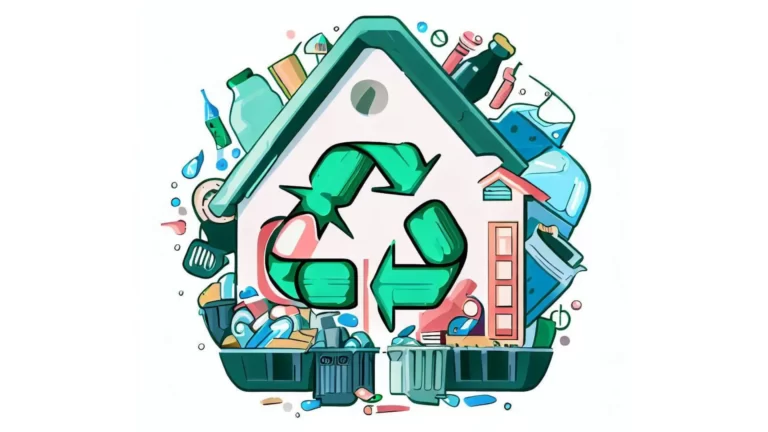In today’s world, the importance of household recycling cannot be overstated. As we grapple with the realities of climate change and environmental degradation, each of us has a crucial role to play in mitigating the impacts of waste. This comprehensive guide is designed to help you understand and implement effective recycling practices right in your home.
Household recycling is more than just a trend; it’s a lifestyle change that contributes significantly to waste management and environmental conservation. By recycling, we can reduce the amount of waste sent to landfills and incinerators, conserve natural resources, and save energy. But how exactly does it work? What can be recycled, and what can’t? How can you make recycling a seamless part of your daily routine?
In the following sections, we will delve into these questions and more, providing you with a thorough understanding of household recycling. From the types of materials that can be recycled to the process of recycling itself, and even how to navigate the challenges that come with recycling, this guide has got you covered. Let’s embark on this journey towards a more sustainable and eco-friendly lifestyle.
Understanding Household Recycling
Household recycling involves the process of converting waste materials from your home into reusable objects. It’s a crucial part of waste management strategies, aiming to reduce the amount of waste we generate and its impact on the environment.
Recycling starts with you. It begins when you choose to place a plastic bottle or a piece of paper in a recycling bin instead of the trash. These small actions add up over time, leading to significant environmental benefits. By understanding what materials can be recycled and how to recycle them properly, you can make a substantial difference in your local community and the world at large.
What Can Be Recycled at Home?
Many everyday items in your household can be recycled. These include:
- Plastic: Items such as water bottles, milk jugs, and detergent bottles are typically recyclable. However, not all plastics are created equal. It’s important to check the recycling symbols on each item, usually found at the bottom, to determine if it’s recyclable in your area.
- Paper: Newspapers, magazines, mail, and cardboard boxes can all be recycled. Remember to remove any plastic windows or liners before recycling.
- Glass: Glass bottles and jars can be recycled endlessly without loss of quality. However, other types of glass, like window panes and light bulbs, usually have different recycling processes.
- Metal: Aluminum cans, tin cans, and foil are commonly accepted in most recycling programs.
- E-Waste: Electronic waste, such as cell phones, computers, and TVs, can often be recycled through special e-waste recycling programs.
It’s important to note that not all items can be recycled curbside. Some items, like batteries, light bulbs, and certain electronics, may require special recycling programs. Always check with your local waste management facility or recycling center to ensure proper disposal.
The Recycling Process
Recycling is a complex process that involves several steps:
- Collection: Recyclable materials are collected from households, either through curbside pickup or drop-off centers.
- Sorting: The collected materials are sorted by type at a recycling facility.
- Processing: The sorted items are cleaned and processed into raw materials, such as plastic pellets or paper pulp.
- Manufacturing: These raw materials are then used to manufacture new products.
- Purchasing Recycled Products: The cycle is completed when consumers purchase products made from recycled materials, supporting the market for recycling.
By understanding this process, we can better appreciate the importance of our role in the recycling chain. From proper sorting to buying recycled products, our actions directly impact the effectiveness of recycling.
In the next sections, we’ll delve deeper into the different types of household recycling and how you can start recycling at home.
Types of Household Recycling
There are various types of household recycling, each dealing with different materials. Understanding these types can help you recycle more effectively:
- Plastic Recycling: This involves recycling items like bottles, containers, and plastic bags. However, it’s important to note that not all plastics are recyclable. Always check the recycling symbol and number on the item.
- Paper Recycling: Newspapers, magazines, cardboard, and other paper products can be recycled into new paper goods. Remember to remove any non-paper components like plastic windows or metal staples.
- Glass Recycling: Glass bottles and jars are recyclable. However, other types of glass, such as windows or ovenware, are not typically accepted in regular recycling programs due to their different melting points.
- Metal Recycling: This includes items like aluminum cans, tin cans, and foil. Some larger metal items may need to be taken to a special recycling facility.
- E-Waste: Electronic waste, such as old cell phones, computers, and TVs, should be recycled at designated e-waste facilities.
- Battery Recycling: Due to their potentially hazardous components, batteries should be recycled at specific drop-off locations.
- Green Waste: Yard waste like grass clippings, leaves, and branches can be composted at home or picked up by local waste management services.
How to Start Recycling at Home
Starting to recycle at home is easier than you might think. Here are some steps to get you started:
- Waste Segregation: Separate your waste into recyclables and non-recyclables. This is the first and most crucial step in recycling.
- Use Recycling Bins: Use separate bins for different types of recyclables – one for paper, one for plastic, and so on. This makes the recycling process easier and more efficient.
- Curbside Recycling: Many cities offer curbside recycling programs where they pick up your recyclables right from your doorstep.
- Recycling Pickup: If curbside recycling is not available, find out if there are recycling pickup services in your area.
Remember, recycling is just one part of the waste management hierarchy, which prioritizes waste reduction and reuse before recycling. Always consider if you can reduce your waste or reuse items before deciding to recycle.
In the next sections, we’ll explore how you can get involved in recycling programs in your community, and how to navigate the challenges that come with recycling.
Recycling Programs and Community Involvement
Getting involved in your local community’s recycling programs can make your recycling efforts even more impactful. Here’s how:
- Local Recycling Centers: Most communities have local recycling centers where you can drop off recyclables that aren’t accepted curbside. These centers often accept a wider range of items, including e-waste, batteries, and certain types of plastic.
- Community Recycling Events: Many communities host special recycling events, where you can bring items like electronics, hazardous waste, or large appliances. These events can be a great way to recycle items that require special handling.
- Recycling for Kids: Encourage your children to recycle by making it a fun and educational activity. Many schools have recycling programs that teach kids about the importance of recycling and how to do it correctly.
Challenges and Solutions in Household Recycling
While recycling is an essential practice in waste management, it’s not without its challenges. Here are some common obstacles and innovative solutions:
- Contamination: Non-recyclable items or dirty recyclables can contaminate an entire batch of recycling, making it unprocessable. Solution: Ensure you’re only recycling accepted items and always clean your recyclables before disposing of them.
- Lack of Knowledge: Many people want to recycle but aren’t sure what can be recycled or how to do it properly. Solution: Education is key. Learn about your local recycling rules and share this knowledge with friends, family, and neighbors.
- Inconvenience: Some people find recycling inconvenient or time-consuming. Solution: Make recycling easy by setting up a simple system in your home and taking advantage of curbside pickup or recycling drop-off centers.
Beyond Recycling: Other Sustainable Practices
Recycling is just one aspect of a sustainable lifestyle. Here are some other practices to consider:
- Composting: Turn your food scraps and yard waste into nutrient-rich compost for your garden.
- Upcycling: Instead of throwing things away, consider how you might give them a new life. This could be as simple as using a glass jar to store leftovers or as complex as turning an old ladder into a bookshelf.
- Donation Centers: Items that are still in good condition but no longer needed can be donated to local charities, extending their life and reducing waste.
- Waste Reduction: The most effective way to reduce waste is not to create it in the first place. Consider how you can reduce your consumption and choose products with less packaging.
- Zero Waste Lifestyle: This lifestyle choice aims to send nothing to the landfill by reducing consumption, reusing, recycling, and composting.
In conclusion, household recycling is a powerful tool in our fight against waste and environmental degradation. By understanding and implementing effective recycling practices, we can each contribute to a more sustainable world. Remember, every little bit helps, and your efforts truly do make a difference.
Conclusion
Recycling at home is more than just an environmentally friendly practice; it’s a commitment to our planet and future generations. By understanding the importance of household recycling and implementing the practices we’ve discussed, you can make a significant impact on waste reduction and resource conservation.
The journey towards a more sustainable lifestyle doesn’t stop at recycling. Composting, upcycling, donating, and reducing waste are all integral parts of a holistic approach to sustainability. The zero-waste lifestyle, while ambitious, represents the ultimate goal of consuming responsibly and wasting as little as possible.
Remember, every small action counts. Whether it’s choosing to recycle a soda can instead of throwing it in the trash, composting your kitchen scraps, or deciding to repair an item instead of replacing it, these decisions add up. Together, we can make a difference and help create a more sustainable world.
Frequently Asked Questions (FAQs)
To wrap up, let’s address some frequently asked questions about household recycling:
What household items should be recycled?
Common household items that can be recycled include paper, cardboard, plastic bottles and containers, glass bottles and jars, and metal cans. Always check the recycling guidelines in your area as they can vary.
What can you do to recycle at home?
Start by separating your waste into recyclables and non-recyclables. Use separate bins for different types of recyclables, and clean items before recycling them. Take advantage of curbside recycling programs or drop-off centers in your community.
What can’t be recycled in household recycling?
Certain items like plastic bags, styrofoam, and certain types of glass are often not accepted in standard recycling programs. Additionally, hazardous waste like batteries, paint, and chemicals require special disposal. Always check with your local waste management facility for specific guidelines.
How can I reduce contamination in my recycling?
Ensure you’re only recycling items accepted by your local program and clean your recyclables before disposing of them. Rinse out containers and make sure paper and cardboard are dry and free from food waste.
Are all plastics recyclable?
Not all plastics are recyclable. Plastics are categorized into seven types, and not all of these are accepted by recycling programs. Always check the recycling symbol on the item, which includes a number from 1 to 7, and verify with your local recycling guidelines.
What should I do with electronic waste?
Electronic waste, or e-waste, should be recycled through special programs and not included with your regular household recycling. Many electronics retailers offer e-waste recycling and special e-waste collection events may be held in your community.
Can I recycle old clothes and textiles?
Many local charities and organizations accept donations of used clothing in good condition. For worn-out clothes and textiles, look for special recycling programs in your area—some retailers even offer take-back programs for old items.
What’s the difference between recycling and composting?
Recycling involves processing used materials into new products to prevent waste, while composting involves breaking down organic waste like food scraps and yard waste into a nutrient-rich soil conditioner.

